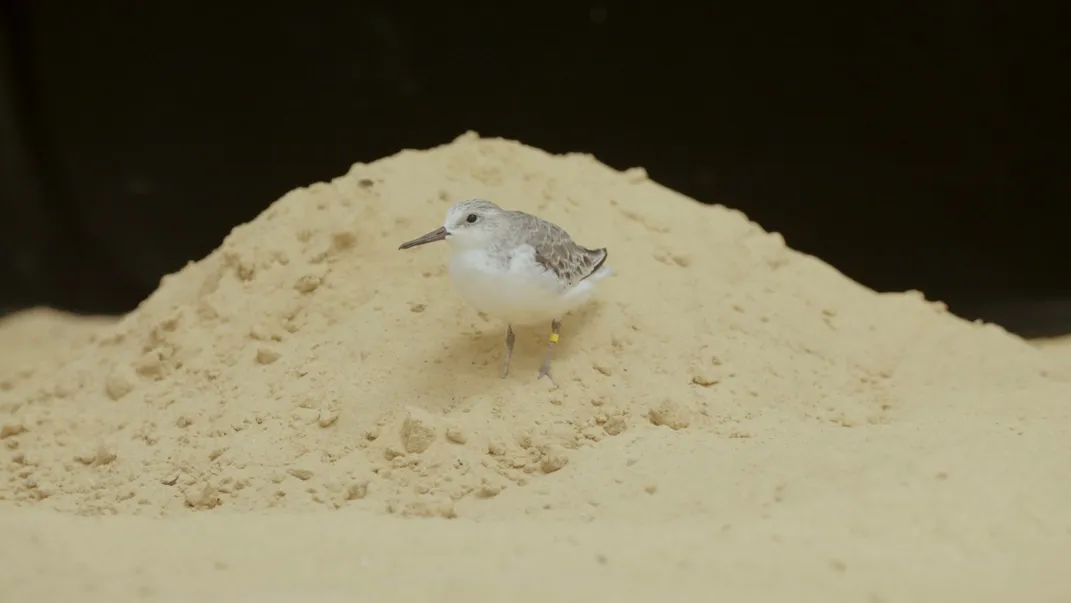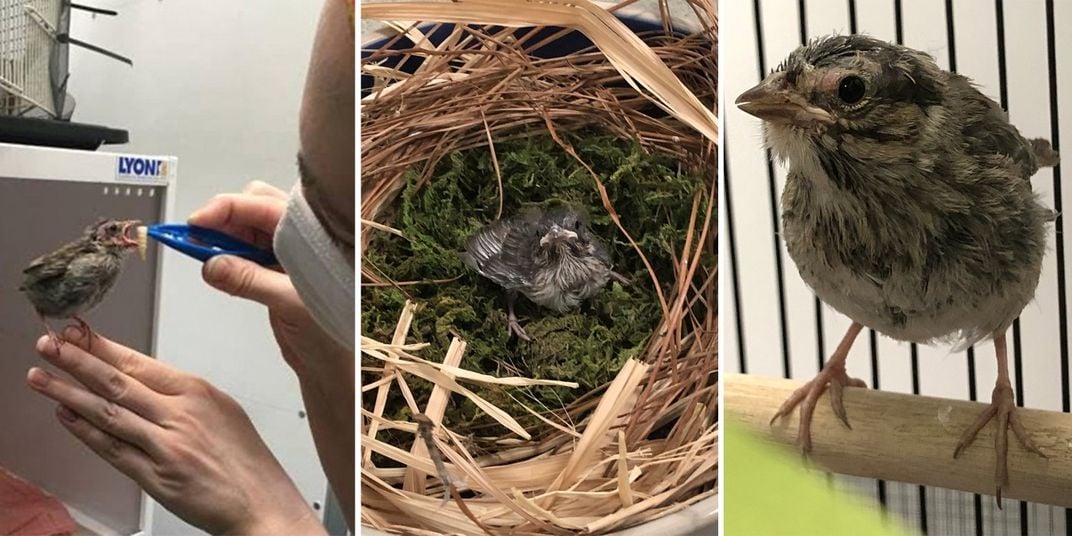NATIONAL ZOO AND CONSERVATION BIOLOGY INSTITUTE
Is the Secret to Saving Migratory Birds in the Meal Prep?
The Smithsonian’s National Zoo has many beaks to feed, including 23 species of migratory birds. Find out how keepers and nutritionists help individual animals stay physically fit and healthy, even as their physiology changes naturally with the seasons.

The Bird House team at the Smithsonian’s National Zoo has many beaks to feed, including 23 species of migratory songbirds and shorebirds. But what happens when they are hungry to migrate and there’s nowhere to go? Curator Sara Hallager and nutritionist Erin Kendrick share some of the valuable lessons they have learned from taking these marvelous migrators under their wing.
Come fall and spring, migratory songbirds and shorebirds are programmed to do two things: fly and eat. In preparing for the long journey ahead, these birds exhibit a normal behavior called “migratory restlessness.” During this period, they don’t sleep much at night. They eat more. They put on a lot of weight. They expend all that energy (and those extra calories) as they embark on their marvelous migrations.
But what happens when those birds cannot travel, say, because they are housed in a Zoo? Do they gorge themselves, even though they have nowhere to go? How do keepers and Zoo nutritionists help individual animals stay physically fit and healthy, even as their physiology changes naturally with the seasons?
The answer lies in the meal prep.
Before we get into the ins-and-outs of our birds’ diets, let’s look at how they eat in the wild.
VIDEO: Mealworms are on the menu for the Zoo’s American avocets. To help them acclimate to sharing a space with their caretakers, keeper Lori Smith crouches a short distance away. She tosses the tasty snacks onto a placemat, and the avocets gobble them up.
Songbirds know it’s time to migrate in the fall, when their food staples (like bugs and berries) decrease. In the spring, they get the urge to migrate back to their breeding grounds for one reason — insects — which provide essential protein to newly hatched chicks. There aren’t enough insects in the tropics to feed both year-round residents and visitors, so migratory species return home in the spring. There, they find an abundance of food resources for themselves and their chicks, until the cycle begins again.
Like songbirds, shorebirds follow their prey: aquatic and terrestrial insects, crustaceans, mollusks and very small fish. Most insects are only on the menu during the Northern Hemisphere summers. To find food the rest of the year, shorebirds need to fly south.
Stopover points, including the Delaware Bay on the Eastern Shore, are critical to shorebirds’ journeys. They fill up on fattening foods, such as nutrient-rich horseshoe crab eggs. Food is fuel. Without enough of it, a bird may leave the stopover point late and miss the opportunity to mate. They may find a mate, but lack the energy to breed. Or, they may die during the grueling journey.
Migratory birds in human care do not have to worry about finding food like their wild counterparts do. However, our experience has shown us that these birds can gain (or lose) weight very quickly with the seasons, even if their diets remain the same. They appear to be hard-wired to do this.
VIDEO: Over the summer, we celebrated the arrival of three wood thrush chicks — two females and one male — June 9, 10 and 12. This was incredibly exciting for several reasons, not the least of which is that mom hatched at the Zoo last year.
Knowing that their weight fluctuates depending on the season, we use what we know about each species’ food preferences, weight and physiology to make daily tweaks and seasonal adjustments to their diets. A species-appropriate, nutritionally balanced diet will support a migratory bird over its lifetime, through breeding, raising chicks, growth and eventually geriatric care. As such, we aim to keep them within the weight ranges that their wild counterparts exhibit.
During breeding season, songbirds’ drive for insect consumption increases greatly. So, we increase the amount of insects we feed them, and decrease our plant-based offerings. Heading into winter, we do the opposite. Because there are naturally fewer insects, we feed (and the birds consume) more plant parts.
Shorebirds seem to have hearty appetites year-round. They receive pellets formulated for insectivorous animals as well as chopped shrimp, krill, mealworms crickets, clam meat, mussels and the occasional crab. It has been remarkable how well they have taken to their Zoo diets. Some birds even consumed pellets immediately upon arrival!

You might be wondering: what would happen if we didn’t make any seasonal adjustments to the birds’ diets on a regular basis? Since our birds don’t migrate, the enormous store of energy would lead to perpetually fat birds if they did not lose weight every year. This could lead to health issues, or even death.
Even with diet adjustments, some individual birds may hold onto the migratory weight longer than others. Some may lose weight more quickly than we would like. They key to keeping our birds healthy is adjusting the amount of food they receive on an as-needed basis to ensure they stay within a healthy range.
Through positive reinforcement training, Bird House keepers are able to regularly monitor our animals’ weights. Keepers cue the birds to voluntarily “station” (stand still upon a scale) while they take note of their weights. If the birds choose to participate, they receive a favorite food item as a reward.
In addition to these weigh-ins, keepers and the nutritionist routinely monitor fat stores on the birds’ bodies by looking under their feathers, a practice that helps us further assess their body condition and health. Sometimes, no matter how we adjust a bird’s diet, he or she may not lose weight due to their programed physiology. In that scenario, it takes a lot of patience, observation and collaboration to ensure a bird isn’t experiencing adverse effects from excess weight. Typically, though, a bird’s weight will return to normal at the end of migration season.
While zoos and aquariums have successfully kept migratory songbirds and shorebirds for many years, our team is taking it to the next level. Understanding the relationship between migratory physiology and seasonal diets will only help us to understand these birds and their needs, both in the wild and in zoos.
With the Bird House under construction and our animals housed in temporary quarters, we are able to acutely monitor and fine-tune their needs. It is a luxury to have this mini research opportunity. Once construction is complete and our birds move into the large aviary, we will not be able to manage individuals in the same way. But, that’s ok! We can apply what we have learned these past three years to the management of the larger aviary. (A subset of our songbirds will remain off-exhibit so we can continue our breeding and behavior research.)
This is a critical time in the history of North American songbird and shorebird conservation. As populations decline drastically in the wild, the possibility of bringing them into human care to save their species becomes more real. Rather than wait and see what fate holds for these magnificent migratory birds, the Smithsonian’s National Zoo is proactively studying their nutritional needs and management while they are still common. We are just at the beginning of a long journey that will take decades to perfect. With the information we have already learned, though, we will be ready to take wild birds under our wing when the need arises.
This story appears in the December 2020 issue of National Zoo News. In early 2022, the Smithsonian's National Zoo’s historic 1928 Bird House will transform into a first-of-its-kind attraction that immerses visitors in the annual journeys of western hemisphere birds.



